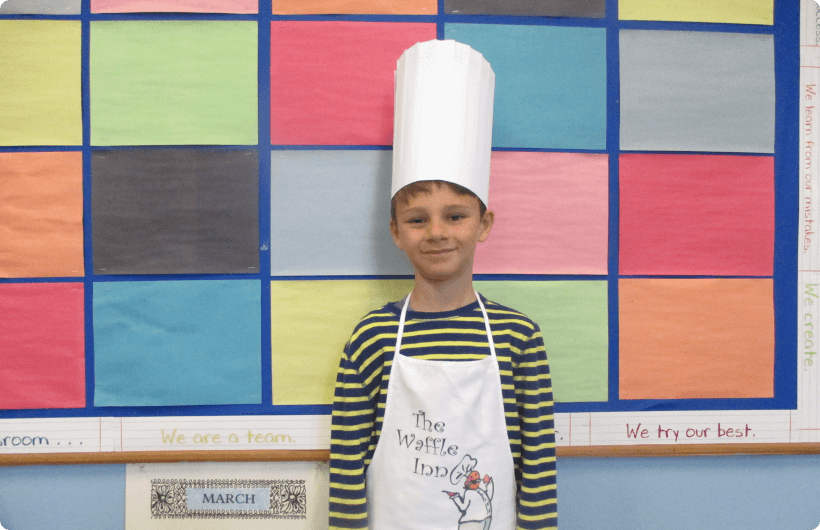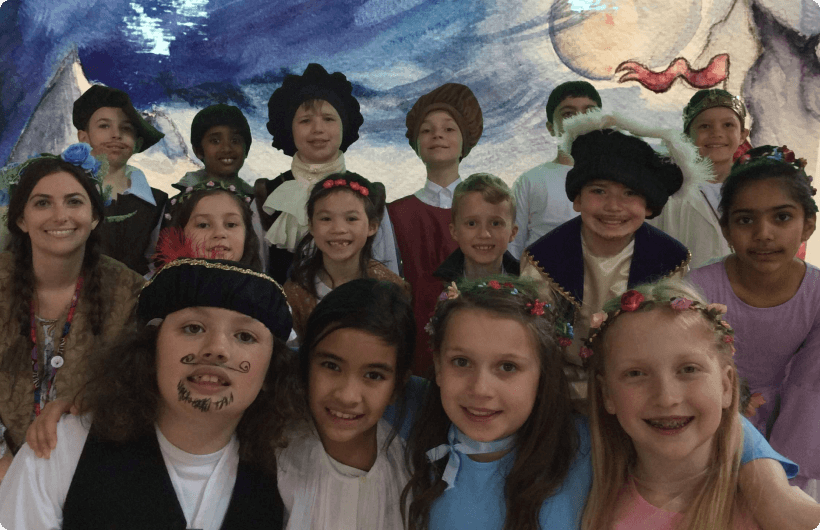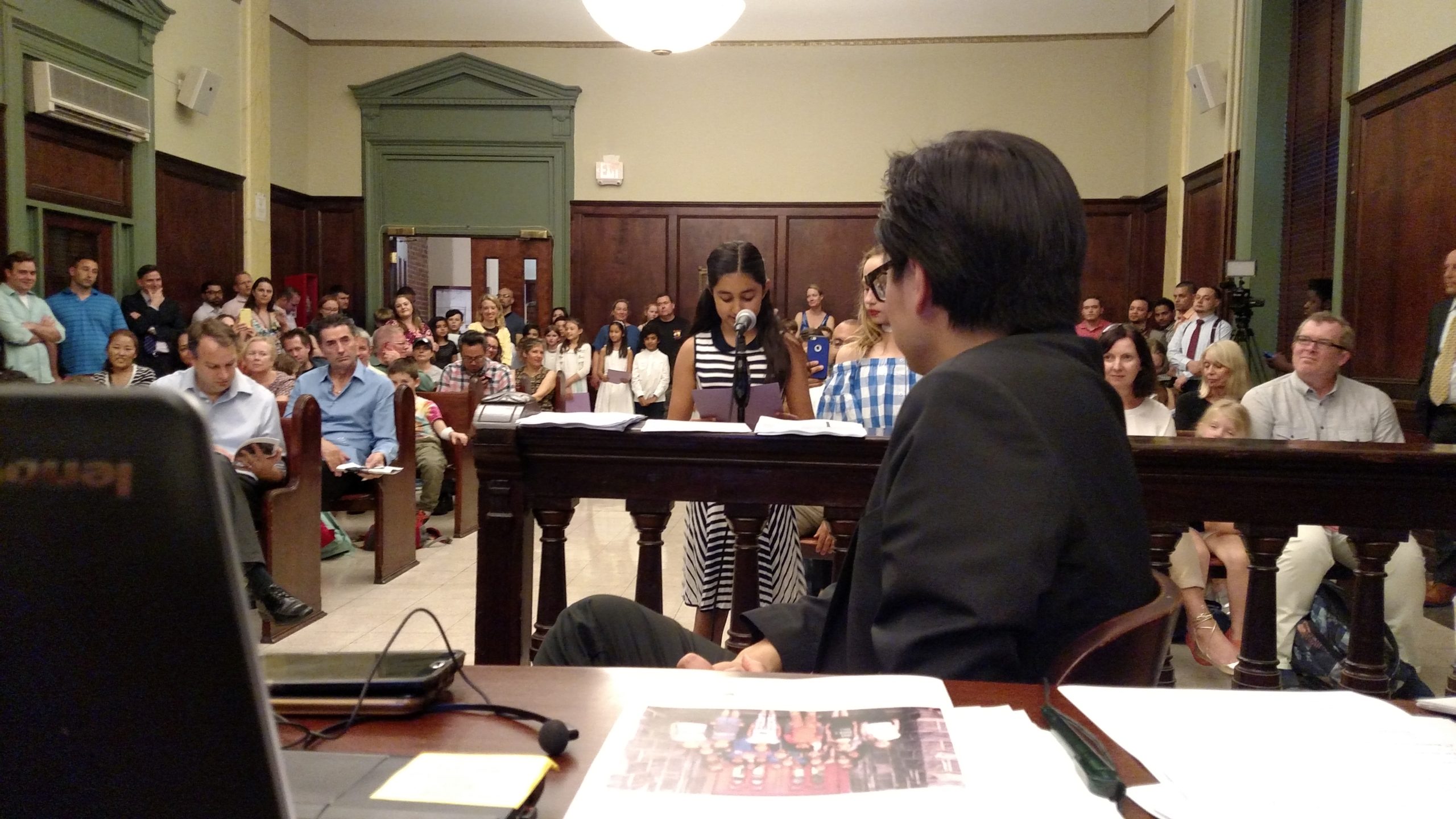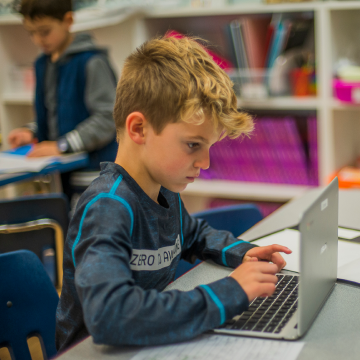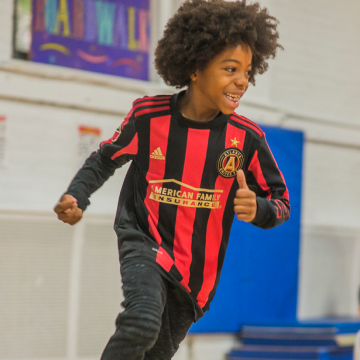GRADES 1-4
Elementary School
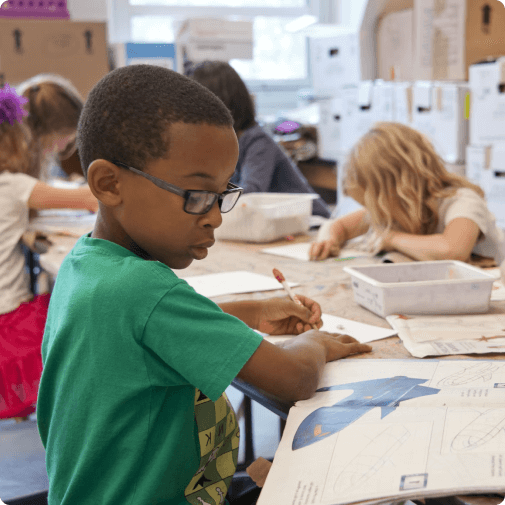
Children learn best when they find personal meaning in their study.
The curriculum includes a number of experientially based, hands-on learning activities and programs. First Graders study their community, Second Graders study the United States, and Third Graders study the world. Fourth Graders hone all of the experience and skills developed through their Elementary years to identify and investigate an issue in their community. This action research course culminates in a formal presentation to the Hoboken City Council.
Milestone Projects
Grade 1 ~ Waffle Inn
Each year the class takes a trip to a restaurant in Hoboken to see how a real restaurant is run. The students see the kitchen and have an opportunity to talk to the staff about their responsibilities. The class returns to school with a lot of ideas for their own restaurant!
Prior to the restaurant opening, each student must fill out an application explaining what job he or she would like and why he or she would be successful. The “applicant” is also required to attend an interview with the restaurant managers (a.k.a. the teachers) during which they must answer challenging questions about how they would handle given situations. Finally, students create menus, advertisements, and invitations, and solicit parent volunteers to bring in necessary supplies.
On the day of the big event, hosts and hostesses greet each class as students enter the restaurant. Servers take orders and bus people help to clean and reset tables. Parent volunteers are always present to help make the waffles while the student chefs add the desired toppings. Cashiers collect Waffle Inn money and distribute a notepad and pencil to each customer as a souvenir. The First Graders enjoy serving the other classes, but their favorite part always comes at the end of the day when they are served waffles, with the works of course, by their own parents.
This project is a meaningful part of the curriculum as it reinforces lessons around money, which is introduced during First Grade. It also allows students to learn more about the jobs and businesses in the local community. Finally, the students learn the importance of working together when they realize that each job is important and that the restaurant cannot run smoothly without everyone doing their part.
Grade 2 ~ U.S. Postcard Project
As the postcards arrive, the students excitedly locate the state on the map and hang up the card. In doing so, the students gain a better understanding of state placement. They also use a tally chart to record the number of postcards that have been collected. Throughout the project, the students also work on puzzles, play games, and read books about the United States. After December break, the students use learned skills to write letters to chambers of commerce in the states from which they have not received postcards. After each state is represented on the class map, the group compiles the data during math class and creates a bar graph.
To culminate the study, each student chooses a state to research and, using various research materials, creates a travel brochure. The students hone their technology skills when searching for data on the internet and creating a number of the brochure pages digitally. This project allows students to explore the United States in a way that is meaningful to them and to complete learning projects across the curriculum. Each year the class collects over 100 postcards and receives at least one postcard from each state!
Grade 3 ~ Bard Bash
During the second trimester, the Third Graders audition for their roles and begin practicing their lines for filming. The majority of the trimester is spent preparing for filming. The students work together to create props and costumes. They learn how to work with a green screen and editing software to produce their final product. Through this experience, the students learn the value of working together, accountability, and responsibility.
During the third trimester, students use their knowledge of Shakespeare and Elizabethan England to plan a Shakespearean celebration called the “Bard Bash,” similar to a Renaissance Faire. They plan various activities and entertainment following the premiere of their movie. Students and parents alike enjoy this magical trip back to the Elizabethan era.
Grade 4 ~ Action Research
An Overview of our Elementary Grades Curriculum
Grade 1
First grade is a time when children build strong friendships with their peers and their friendships become just as important as their family relationships. They thrive on encouragement and have a tremendous capacity for enjoyment. Students often work in small groups to encourage social development and relationship building. However, the classroom also supports students who crave independent work. The room is set up to encourage independence and growth. By the end of First grade, the class runs their milestone project, the Waffle Inn. This long standing tradition at All Saints allows social First graders to work together cooperatively and to understand that each person in a business or community matters to the success of the whole.
Building on the skills developed in Kindergarten, the Language Arts curriculum in First Grade classroom teachers are intentional about working in small groups to maximize the level of attention and personalized instruction each student receives. In Handwriting, students begin to focus more on letter formation. Specific phonemic awareness concepts covered in First Grade include: short and long vowels, double consonants, l, r and s clusters, contractions, final clusters, and the digraphs sh, th, wh, ch, and tch. While writing, students focus on a number of grammatical skills including: proper usage of capitalization and punctuation, naming and action words, parts of the sentence, proper nouns and pronouns, present tense and the verb endings –s, -ed, and –ing.
First Grade is an exciting time in the development of mathematical thinking. The curriculum covers a wide variety of concepts, which students are encouraged to explore in depth. The teacher focuses on problem-solving strategies throughout instructional time, and encourages students to articulate their methods and strategies to deepen their own learning as well as benefit from the learning of their classmates. Curriculum Units in First Grade include: numerical operations; basic addition and subtraction, number sense; counting to 100 and number lines, skip counting, time, reading and making graphs, calendars, money, geometry; 2-dimensional shapes, 3-dimensional shapes, transforming shapes and symmetry, standard and non-standard measurement, an introduction to double digit addition and subtraction, estimating, and place value.
The First Grade science curriculum builds on this intuitive exploration of the natural world while introducing more formalized experimentation and opportunities for hands-on study. Students are challenged to “think like a scientist” as they embark on experiments to help them learn about the natural world. Science instruction in all topics involves the making and testing of hypotheses, and the drawing of logical and scientific conclusions. Students learn about the proper use of scientific tools and making and testing hypotheses. Units in First Grade include Animals, Plants, Environments, Earth’s Resources, Weather and Seasons, Objects in the Sky, All About Matter, and Forces and Energy.
In an effort to better understand their world, First Graders use what they know about their life in school as a jumping-off point to investigate their neighborhood and community. Students learn about the makeup of a community, including the people, businesses and municipal structures in place to ensure the safety and rights of its inhabitants. Through an in-depth study of Hoboken, students study the aspects that make up this community (i.e. parks and recreation, city services, retail, etc). Later in the year students use this knowledge and apply it to their study of colonial communities, which allows them to make comparisons between our community today and colonial communities of the past.
Grade 1 Students partake in several co-curricular activities such as music, dance, art, physical education, and world language. Please see our Beyond Core Academics page.
Grade 2
The Second Grade classroom at All Saints encourages children to learn in an environment where their natural curiosity and strong internal desire to discover and invent is supported. Calm, industrious and determined, Second graders are hard workers who are determined to do their best. They become more confident and respond well to class projects and traditions which build a sense of unity and cohesion. They respond well to studies of other cultures, and stories that concern fairness and justice. Interested in classifying and discovering how things work, the Second Grade projects of studying and building bridges as well as learning about areas of the United States are a wonderful match for this age. Second Grade is a year where seven- and eight-year-olds truly practice working independently and cooperatively.
The beginning of the Second Grade is marked by a class of students who are well on their way to becoming fluent, independent readers. In this grade, students make the critical shift from “learning to read” to “reading to learn.” Throughout the year, students sharpen their reading strategies by reviewing and applying strategies used by good readers: predicting, questioning, monitoring, summarizing, and evaluating. Students are exposed to a wide variety of literary genres as a way of sparking interest in new and expanded opportunities for reading pleasure and discovery. Conventions for written language (spelling, grammar, usage, etc.) come into more serious focus in Second Grade, and students are asked to edit and revise their written work as a method for improvement. Major writing projects focus on poetry using the five senses, formal paragraph structure, letter writing and exploration of sending letters (writing out envelopes), “how to” writing using time-order words, writing biographies about members of the community, and the construction and completion of their very own memoir. While writing, students focus on the following grammatical concepts: homophones, endings, punctuation, synonyms and antonyms, proofreading, alphabetizing, compound words, plurals, word families, irregular verbs, and adjectives.
Throughout the year, students use a variety of activities to strengthen their number sense including math games that allow them ways to strengthen their recall of their tens and doubles facts. Students are now asked to think critically about math and to explain their thinking that goes into problem solving. Second Graders are expected to demonstrate proficiency with addition and subtraction facts, and many will dive into studying multiplication facts up to five by the end of the year. Curriculum units in Second Grade include: addition, subtraction, single-digit word problems, tens and doubles facts, number words, tens and ones, skip counting, even/odd, money, estimation, telling time, graphing, calendar, measurement, geometry, capacity, volume, and weight.
In Second Grade, the main goal for science is to encourage students to further develop their emerging skills in observation, description, record-keeping, and investigation. Students are asked to think and act like scientists and to use their knowledge from the outside world to enrich their scientific learning. Examples of science labs include: observing rocks, soil and erosion, imprints, and matter. Students share their learning during Open Science Morning. One of the most exciting units is at the end of the year when they must use their knowledge of bridge structure to design a bridge with a partner. This bridge must withstand the weight of 50 pennies and a simulated earthquake! Many aspects of the Science curriculum support learning that takes place in Social Studies. For example, the study of saving earth’s resources links to the study of the community, and saving resources in Social Studies and their study of bridges links to the Hoboken-New York study in Social Studies along with the study of the history of the Brooklyn Bridge. These opportunities for cross-curricular connections reinforce student learning and support authentic discovery.
Second Grade Social Studies is a broad-based course of study nurturing the developing sense of one’s self in relationship to one’s neighborhood, community, the state, and the world. Students review the makeup of a community, including the people, businesses and municipal structures in place to ensure the safety and rights of its inhabitants. Throughout the year, students are introduced to famous Americans who changed the face of history and our nation, and are asked to consider the character traits required to be a responsible citizen in a democratic, pluralistic society. Curriculum Units include: neighborhoods, mapping and cardinal directions, landforms, natural resources, government, homelessness, Hoboken-NYC connections, Rosa Parks, and Rachel Carson.
Grade 2 Students partake in several co-curricular activities such as music, dance, art, physical education, and world language. Please see our Beyond Core Academics page.
Grade 3
Students in the Third Grade are known for their enthusiasm and an infectious belief that they are capable of anything. This attitude allows them to create dynamic science projects, enjoy field trips and build elaborate sets to showcase their understanding of a topic. Their interest in the larger world allows them to study countries and share their knowledge with the class. They are even able to take on challenges such as creating a “Bard Bash,” which culminates in a movie version of a Shakespearean play. Third graders are encouraged to work things out with their peers and practice kindness in the classroom. As third graders explore the boundaries with social graces and become more self aware, character education becomes a priority of the classroom. They feel safe to sometimes play with language and act out social concerns. Eight-year-olds love to push themselves to the limit and explore the world at large. As such, the Third grade class can oftentimes be found having class outside or eating their lunches in the courtyard on a sunny day.
Because of their strong foundation in Language Arts in the previous years, students in Third Grade are challenged to develop and hone their literacy skills to a very high standard. Students are provided with a variety of reading experiences, including partner reading, whole-group lessons, guided reading, and other strategies to help them grow as readers. The curriculum requires students to read with a purpose, to gather information, to organize their thoughts for classroom discussion, and to write essays and reports. A major focus in Third Grade is the life and works of William Shakespeare. Students are also engaged in a spelling curriculum that is designed to lead students toward mastery of essential spelling skills. In language, the students will learn more about punctuation, parts of speech, sentence structure, and grammar. A major focus of writing in Third Grade is the focus on writing with an author’s voice and focusing on conventions. Finally, it is in the Third Grade that students learn how to write in cursive.
- Third Graders are active mathematicians and gain greater proficiency and ease with basic addition and subtraction, while building on this knowledge base to secure their understanding of regrouping and explore multiplication and division. The class begins the year with a thorough review of place value, and regrouping. The students then explore multiplication, learning different strategies, games and activities to help them understand the core concept of multiplying. Students then use their knowledge of multiplication to begin exploring the concept of division. They also explore the concept of fractions, and become more skilled at working with fractions in different forms. These more sophisticated skills and strategies support an exploration of a wider scope of concepts, including 2-dimensional and 3-dimensional geometry, measurement, probability and data collection. Other Curriculum Units include: place value, data analysis, clock, calendar, measurements, decimals, and probability.
In Third Grade, the focus of science instruction shifts to the classroom as a laboratory. Students begin to undertake the study of increasingly abstract scientific concepts. Students work like scientists as they learn how to ask questions designed to gain knowledge and understanding, and learn how to follow lab procedures, how to record data, and how to extrapolate information from that data. Curriculum Units include: People and Resources, Physical Science (Engineering Process, Electrical and Magnetic Forces, Force and Motion, Space, and Life Sciences (Plants and Animals.) The Third Grades use design thinking to design and build machines to solve a local eco-problem. The students share their results with their parents at Open Science Morning.
Third Grade students begin the year by forming a cohesive classroom community. Next, the Third Graders review map skills and learn how to find latitude and longitude in preparation for their study of countries. Just as in the previous year, students will collect postcards, but this time from a much broader base – anywhere in the world! During the third trimester, the students write a country research report and create a poster to present at the World Showcase. The students then study immigration. Students learn the reasons why and where people immigrated to the US in the past and present. Students study the conditions surrounding the move to the US and what life was like when immigrants arrived here. They culminate this study by writing three journal entries through the eyes of a person immigrating to Hoboken.
Grade 3 Students partake in several co-curricular activities such as music, dance, art, physical education, and world language. Please see our Beyond Core Academics page.
Grade 4
The Fourth Grade curriculum provides opportunities for independent and group work. Working as a team toward common goals, students develop an appreciation for the value that each child brings to the classroom. Students also have ample opportunity to work independently, and the room is set up to encourage independence and growth. The curriculum includes a series of lessons and studies related to good manners. Practicing common courtesies such as holding a door for a friend or listening when another is speaking allows for a more peaceful classroom environment, diffuses classroom conflicts, and puts into practice important life lessons. These values are extended through the curriculum to writer’s workshop, allowing students to share their writing in a safe environment with classmates who are able to listen and allow for a different point of view. By creating an environment where it is safe to discover, explore, share, and grow, Fourth Graders at All Saints are able to successfully navigate this emotional, dynamic year.
- The Fourth Grade Language Arts curriculum focuses on careful inventory of personal skills and areas for targeted focus as a way of preparing students for the academic demands of middle school. A strong emphasis is placed on reading skills and strategies to ensure a capacity to manage a variety of challenging materials including textbooks, essays, rich literature, and historical documents. Students are encouraged to engage fully in classroom discussions about literature and to challenge one another’s thinking by offering opposing points of view and understanding, particularly during Literature Circle meetings. Students are also engaged in a spelling curriculum that is designed to lead students toward mastery of essential spelling skills.
Math activities remain rooted in problem-solving and firsthand, often collaborative experience. Students apply skills, conceptual understanding and number sense that they have already learned to increasingly complex tasks. They extend their working understanding of fractions, measurement, geometry, and data collection and are expected to know their multiplication facts. Students are given several real world opportunities to apply their math skills. Beginning in the Fall, Fourth Graders run two year long fundraisers with proceeds benefiting their New Jersey Adventure Week. Students independently run the School Store to apply their mathematical skills in a practical setting. In the classroom students analyze topics such as, net and gross profits, purchase orders, and marketing.
In Fourth Grade Science, students continue to build on their now sophisticated laboratory skills. Experiments move beyond focusing on the data gathered during a lab to how experiments are designed, how data is gathered, and how this information is recorded and used. Labs also become more independent. Their Open Science Morning focuses on using the design process to come up with an idea that would assist people in the event of extreme weather and natural disasters. Science topics include Studying Science; Severe Weather in U.S. Regions; Space; Energy; Motion and Speed; Electricity; and Animal and Plant Parts and Relationships. Fourth Grade focuses on communicating their findings in a variety of ways.
- The Fourth Grade Social Studies curriculum is focused on New Jersey’s place in our nation’s history. Students begin the year by studying the first inhabitants of New Jersey, the Lenape. Students continue to explore New Jersey’s history during the Colonial Period, along with many other key historical events that shaped the culture and progress of our state. In addition, students learn about and visit the different cities, landmarks New Jersey offers. At the end of the school year, students prepare an all-day boardwalk event for the All Saints community to attend. Students incorporate their understanding of New Jersey history into interactive games and activities of their own creation, creating a fun and engaging, working boardwalk. The Fourth Grade year culminates with New Jersey Adventure Week, a series of trips across New Jersey to important geographical and historic sites.
Grade 4 Students partake in several co-curricular activities such as music, ASL, art, physical education, and world language. Please see our Beyond Core Academics page.

“How lucky are we to be centered in Hoboken where diversity thrives and our children use that exceptional foundation for exploring the wider world around them.”
Nicole Berhaupt, Lower School Division Head
We'd Love to Hear from You:
LOCATIONS
707 Washington Street, Hoboken, NJ, 07030
527 Clinton St, Hoboken, NJ 07030
CONTACT
FOLLOW US
ADDRESS
707 Washington Street, Hoboken, NJ, 07030
527 Clinton St, Hoboken, NJ 07030
CONTACT

